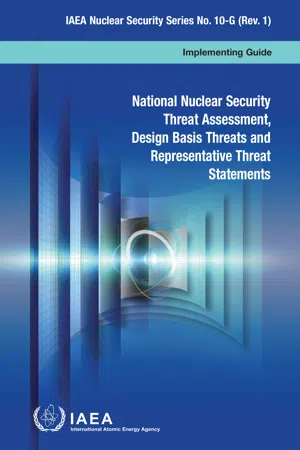1. INTRODUCTION
Background
1.1. The Nuclear Security Fundamentals set out the objective of a nuclear security regime and its essential elements [1]. The Nuclear Security Recommendations indicate what a nuclear security regime should address regarding the following material and associated facilities:
(a) Nuclear material and nuclear facilities [2];
(b) Radioactive material and associated facilities [3];
(c) Nuclear and other radioactive material out of regulatory control [4].
1.2. The identification and assessment of threats provides an essential basis for the selection, design and implementation of nuclear security measures. For nuclear material and other radioactive material that is under regulatory control, and associated facilities and associated activities, the results of this identification and assessment are expressed as a design basis threat or a representative threat statement describing the intentions and capabilities of potential adversaries against which the materials, associated facilities and associated activities are to be protected.
1.3. This publication is a revision of IAEA Nuclear Security Series No. 10, Development, Use and Maintenance of the Design Basis Threat, intended to take into account developments in the field and to ensure consistency in terminology with Refs [1–4], which were published after 2009.
1.4. In addition, the scope of this publication has been broadened to clarify the use of an alternative approach to the design basis threat, to explain how to develop application specific design basis threats and to better address threats involving cyber-attacks [5].
Objective
1.5. The objective of this publication is to provide a step by step methodology for the conduct of a national nuclear security threat assessment, including both physical and computer security aspects, and for the development, use and maintenance of design basis threats and representative threat statements. This includes the following steps:
(a) Defining the roles and responsibilities of the State, competent authorities (including the regulatory body) and operators;
(b) Identifying and assessing threats related to nuclear security;
(c) Developing threat statements such as design basis threats and representative threat statements using the results of the national nuclear security threat assessment;
(d) Using design basis threats and/or representative threat statements to develop nuclear security systems and measures as well as nuclear security requirements;
(e) Maintaining the validity of the national nuclear security threat assessment and its documentation;
(f) Maintaining the validity of design basis threats and representative threat statements.
1.6. This publication is intended for use by States, competent authorities (including the regulatory body), relevant technical and scientific support organizations, and the operators of facilities and activities associated with nuclear material and other radioactive material, including shippers and carriers.
Scope
1.7. The concept and methodology described in this publication apply to the conduct of a national nuclear security threat assessment, including both physical and computer security aspects, and to the development, use and maintenance of design basis threats and representative threat statements for protecting nuclear material and other radioactive material under regulatory control as well as associated facilities and associated activities.
1.8. Guidance on developing a risk informed approach and conducting threat and risk assessments as the basis for the nuclear security of nuclear and other radioactive material out of regulatory control is not provided in this publication; guidance on this topic can be found in IAEA Nuclear Security Series No. 24-G, Risk Informed Approach for Nuclear Security Measures for Nuclear and Other Radioactive Material out of Regulatory Control [6].
Structure
1.9. Following this introduction, Section 2 addresses the national nuclear security threat assessment as part of the application of a risk informed approach. Section 3 provides an overview of the process of conducting a national nuclear security threat assessment and the development, use, and maintenance of the validity of that threat assessment and its documentation as well as design basis threats and representative threat statements. Section 4 outlines the roles and responsibilities of the organizations involved in the national nuclear security threat assessment process. Section 5 provides more detailed guidance on how to conduct a national nuclear security threat assessment. Section 6 describes the development of design basis threats and representative threat statements, and Section 7 provides guidance on their use. Section 8 provides guidance on maintaining the validity of the national nuclear security threat assessment and its documentation and the threat statements. A model design basis threat is provided in the Appendix to this publication.
2. NATIONAL NUCLEAR SECURITY THREAT ASSESSMENT AND THE USE OF A RISK INFORMED APPROACH
2.1. International conventions...
